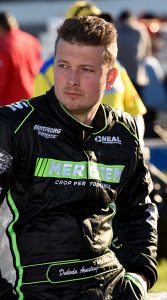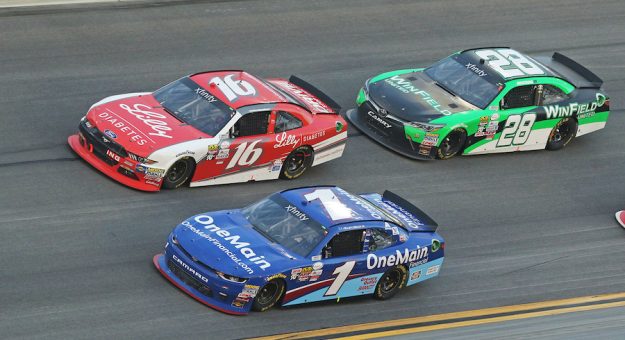It was a terrific opportunity and Armstrong made the most of it. His first partial season was highlighted by some strong runs, notably a podium finish at Salem (Ind.) Speedway. The following year, he won at Talladega (Ala.) Superspeedway and Salem and earned rookie-of-the-year honors. His next logical step was a partial season in the NASCAR Craftsman Truck Series in 2011.
Armstrong knew he needed to bring sponsorship and was fortunate to have supporters who were willing to back him.
“Lucky enough Ferrellgas helped us out, so I got a chance to race with ThorSport,” he said. “We thought we would run a few races, see how it went, and find some more money if we needed to. It just didn’t pan out. They were just starting a third team and we underperformed. They finally built a good truck for me and we had a good race going at Iowa, but we cut a tire down and junked it.”
Armstrong finished third at Michigan near the end of his second season at ThorSport but by then he knew he needed to search for a better opportunity.
“We went our separate ways,” he said. “But I loved ThorSport. Those are amazing people and Duke (Thorson) is great. It just didn’t work out. The toughest thing about stock car racing is that money runs the deal. There just isn’t any way around it. Technology is so advanced and you just have to keep up and perform and there are so many good drivers out there. There are drivers who can win in NASCAR right now sitting on the couch.”

WinField, an agricultural products firm, provided fiscal support and Armstrong used this to secure a ride with team owner Stacy Compton. He completed the full season with Compton and finished 12th in points. Additionally, he added six Xfinity Series races to his schedule, including a stint with Richard Childress Racing.
Next came an opportunity to run Richard Petty’s famed No. 43 in the Xfinity Series.
“Petty Enterprises was doing pretty well,” Armstrong noted. “But they weren’t a top-tier team. We could afford what they asked for the full season and we got caught up in the bright lights of running the 43 and having Richard Petty as an owner. It felt like we must do this.”
Over the course of two full seasons, there was the expected roller-coaster ride, and in the end, he hovered just outside the top-10 points. However, reality set in.
“We had moments where we were good,” Armstrong said. “But it was kind of the same deal. It seems horrible to say but you kind of get what you pay for in these sponsorship deals. If the top-tier teams are looking for $5 to $6 million and you are bringing in two and a half, you are hamstringing your operation. Petty just didn’t have the R&D program that some teams had, but we still had good moments.
“By the end of my last year, our program was better and we were running top 15 every week. We just didn’t have the sponsorship they needed to improve. Everyone’s goal is to get better, so we moved on to JGL Racing.”
JGL Racing, a partnership between James Whitener and Gregg Mixon, provided some of Armstrong’s most satisfying moments in his stock car career.
“It was a much smaller team, but we had more success,” Armstrong said. “We had some good runs for a team that was not projected to do that well. We had a small shop, and we were just a group of guys that knew racing and were doing our thing. We had a Joe Gibbs Toyota, but we did all our own stuff. We weren’t affiliated with anyone. I think both years we just missed the playoffs and we accomplished that because we were really consistent.”
The economy and the overall business environment eventually sealed Armstrong’s fate in the NASCAR world.
“WinField merged with a company called United and when two companies merge people are going to lose jobs and the first thing, they are going to cut is sponsorship,” Armstrong explained. “That is what happened to us and we couldn’t find the next fit.”
An opportunity to sub for injured Matt Tifft in a Joe Gibbs Racing Toyota further shaped Armstrong’s opinion.
“Matt was gracious and let me run his Gibbs car at Iowa,” he said. “I qualified third and ran the most C-minus race I have ever run in my life and finished fifth. I did a horrible job on every restart and fell too far back when we had good tires. We also weren’t using our normal pit crew, so we had horrible pit stops. All of that and we still finished in the top five. I thought right there if I were in that kind of equipment every week I would be contending for wins.
